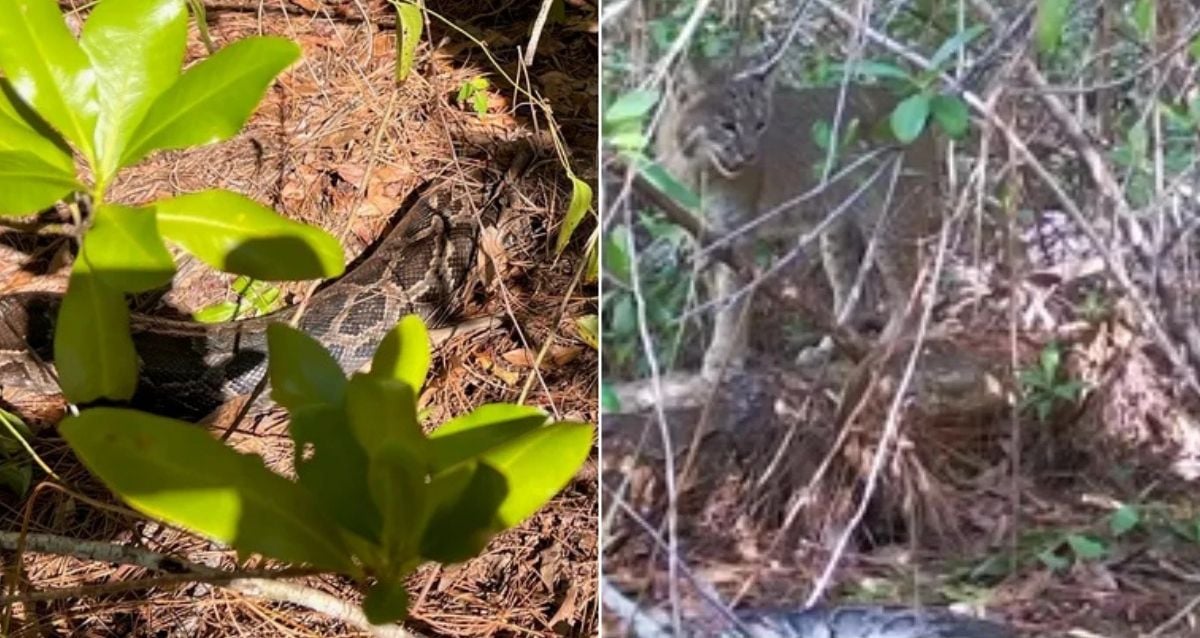Florida Bobcat Turns Predator: Devours Giant 13-Foot Python in Unprecedented Hunt
Ever wonder what happens when a feisty bobcat crosses paths with a colossal Burmese python in the wilds of Florida? Picture this: a bobcat, weighing half as much as its scaly adversary, manages the unthinkable—taking down a python named Loki. Now, while bobcats have been known to snack on python eggs before, this is actually the very first time scientists have caught proof of one killing a full-grown python. Talk about the ultimate David and Goliath moment in the Everglades! Since these invasive snakes slithered into Florida through the exotic pet trade decades ago, they’ve caused nothing but chaos—yet it seems nature is stepping up, nudging the “home team” to start reclaiming their turf. Curious how this unlikely showdown unfolded? Let’s dive into the wild story behind Loki’s final moments and what it means for Florida’s ecosystem. LEARN MORE
Bobcats in Florida have been documented eating python eggs before, but this is the first time that scientists have found proof of a bobcat killing a python.

Conservancy of Southwest FloridaThe body of Loki the python.
In the 1970s and ’80s, Burmese pythons were introduced to Florida via the exotic pet trade. Released into the wild by overwhelmed pet owners, the massive snakes have since wreaked havoc on the local ecosystem. But scientists outside Naples have found evidence that a bobcat killed a python — suggesting that the “home team” is starting to fight back.
The surprising discovery is the first time that scientists have documented a bobcat killing a python in Florida. Still, many hands are needed to eradicate pythons in the state, where they’re considered a damaging invasive species.
‘Score One For The Home Team’
According to reporting from the South Florida Sun Sentinel, the story of the bobcat and the snake started with a 13-foot, 52-pound python named Loki. Biologists were tracking Loki in the hope that he would lead them to female snakes, which they could then humanely euthanize. Instead, they came across Loki’s decapitated body partially buried in the Everglades.

Conservancy of Southwest FloridaLoki’s body can be seen here partially buried under some pine needles.
Loki’s head and neck had been gnawed off and his body partly covered in a “cache,” behavior indicative of a panther or a bobcat. Florida panthers are extremely rare — there are just 200 in the wild — so it seemed likely that Loki had been killed by a bobcat. Because bobcats and panthers are known to return to their caches, biologists set up a trail camera to find out for sure.
Sure enough, Loki’s killer soon wandered back to the site of the python’s body. It was a 25-pound bobcat, a creature half Loki’s weight.

Conservancy of Southwest FloridaThis bobcat was likely the animal that killed Loki.
Pythons have been known to kill bobcats — scientists have even found bobcat claws inside pythons’ bodies — but this is the first time on record that a bobcat has killed a python in Florida.
That said, scientists caution that they can’t know with absolute certainty how Loki died. He could have died before the bobcat found him, though it’s unlikely. Biologists were tracking him and knew that he was in good health. And bobcats are generally not scavenging animals. Thus, it seems most likely that a python and a bobcat met in the Everglades — and the bobcat won.
Scientists suspect that Loki may have been slow or sluggish because of a cold snap, which would have given the bobcat an advantage. But however the snake died, it’s a win for the Florida ecosystem.
The Problem Of Burmese Pythons In Florida
Since their introduction to Florida, Burmese pythons have caused problems in the local ecosystem. According to the South Florida Sun Sentinel, mammal sightings have plummeted 80 to 99 percent in some areas where the snakes are concentrated. But, as the bobcat that killed Loki suggests, Florida’s natural ecosystem is fighting back.
Biologists who track pythons like Loki to female pythons’ nests have started to anticipate losing at least one snake a year. Pythons have become victims to natural predators like bobcats, panthers, and bears. One such snake was an 11-foot, 35-pound reptile named “Pacino.”

U.S. Fish and Wildlife Service HeadquartersA captured Burmese python in Florida. The snakes have become an invasive species since they were introduced via the exotic pet trade in the 1970s and ’80s.
“It was almost like a grenade went off and there was pretty much just the skull,” biologist Ian Bartoszek told the South Florida Sun Sentinel. “He looked like he was killed by a bear, but I can’t tell you 100 percent if he was. I don’t think he was killed by the cold… I think it was a similar situation. He was exposed, and you could tell a bear got this python.”
Bobcats have also been documented raiding python nests, though not outright attacking mother snakes.
All in all, it seems like an encouraging sign to biologists like Bartoszek. Though he was “a little emotional” to lose Loki, a snake he had been tracking for six years, Loki’s death is a positive sign and an indication that natural predators in Florida have started hunting pythons, an invasive species.













